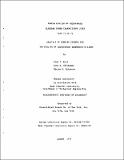| dc.description.abstract | Various pumping arrangements and their pressure profile
control for forced cooling of long pipe type transmission lines
were investigated.
In order to overcome the extensive friction head losses and
provide ample cable cooling, a number of pump stations has to be
used. Since the inner line segments cannot be provided with pressure
control head tanks, line blockages, flow resistance changes, flow
rate changes, pump shutdowns, or other imbalances in one segment can
alter the pressure profile along the entire line, and, when two head
tanks are used, create transverse flow.
Using experimental and analytical methods, it was determined
that the pump - relief valve combination operating as a constant
flow source is superior to the pump - relief valve combination operating as a constant pressure source, and that the configuration
consisting of an even number of loops, each loop having the opposite
flow direction from its neighbor's, is the best solution when operated with only one pressure control head tank.
The simplest, and yet effective, line pressure profile control appears to be the pump bypass, which could be easily implemented
on existing installations. The head tank pressure adjustment, however, is the most effective line pressure profile control scheme, and
should be considered when a new system is being designed. From the
analysis performed on an electric analogy model it was found, that
the head tank pressure adjustment or the pump bypass would be sufficient to mainain the line pressure profile within its working
limits for all practical imbalance sizes, and that, to extend the
range of either of these line pressure profile controls, the emergency
pump shutdown and the pump bypass itself should be based on the pump
discharge, rather than the pump inlet pressure. | en |
